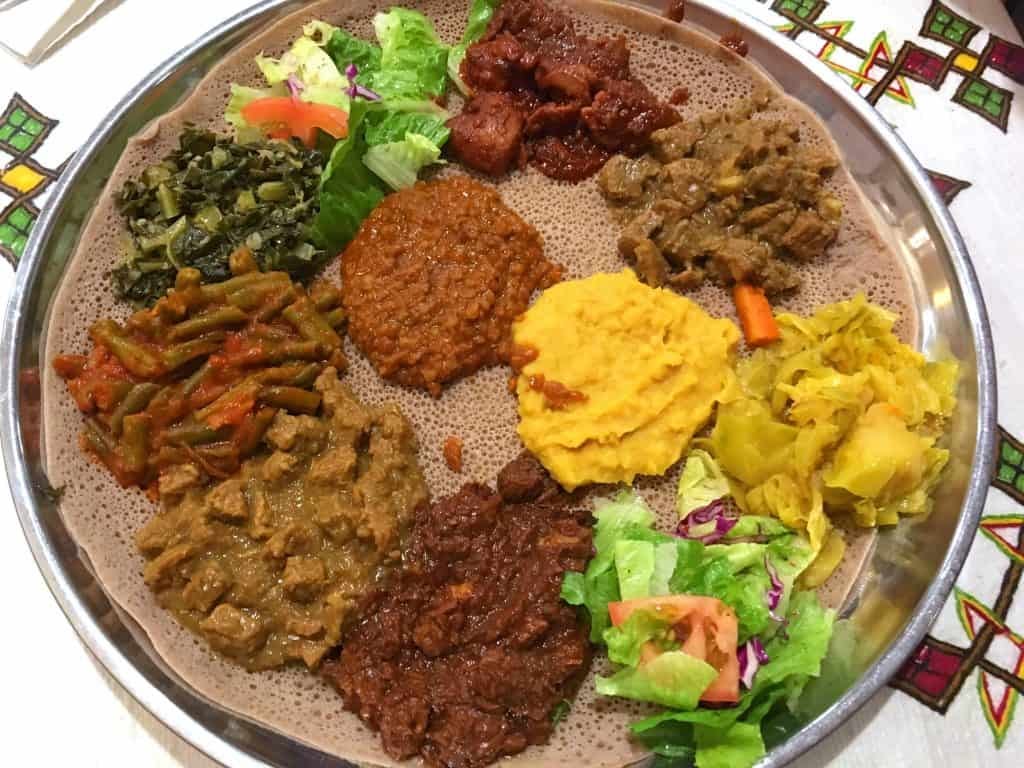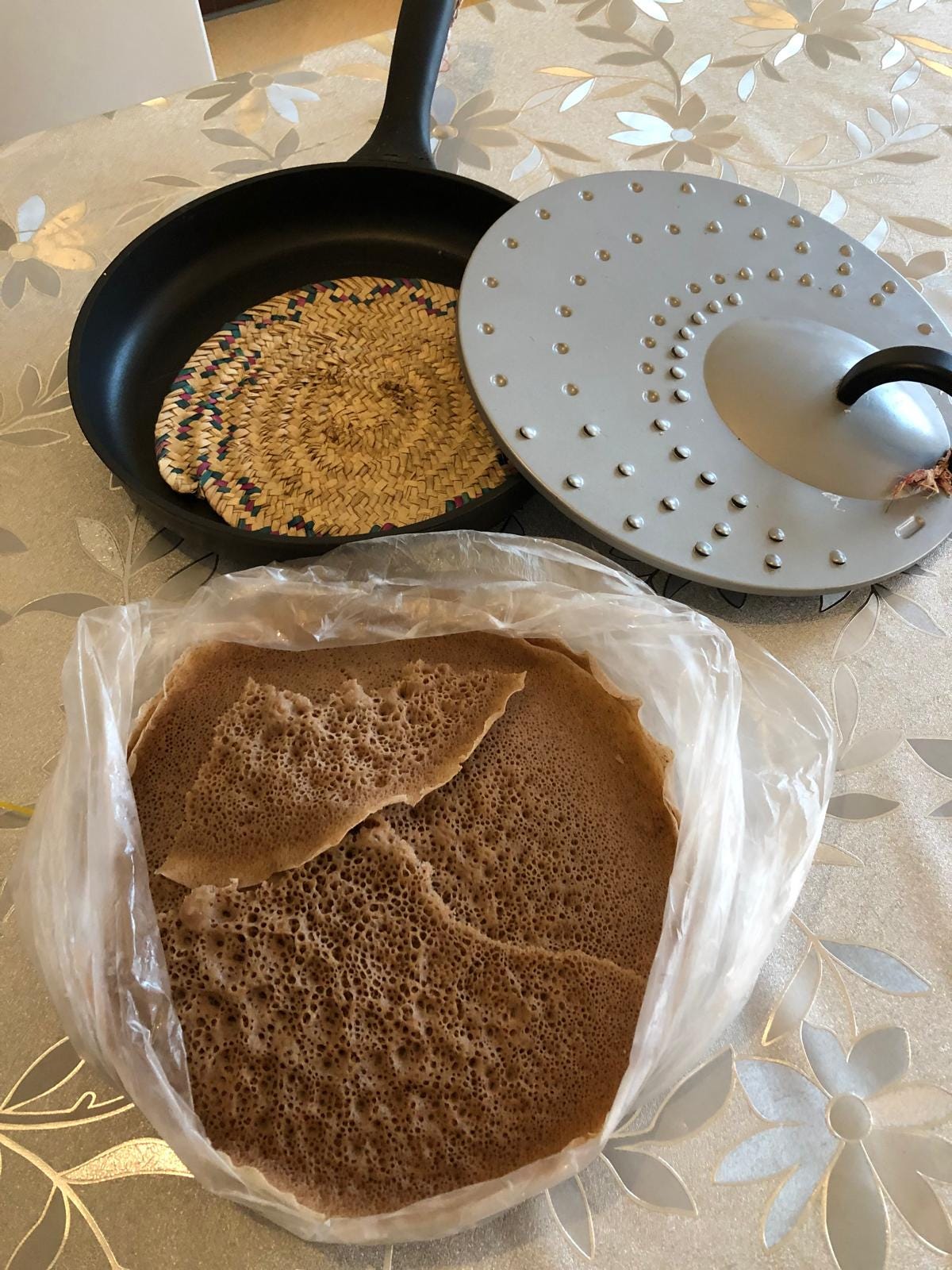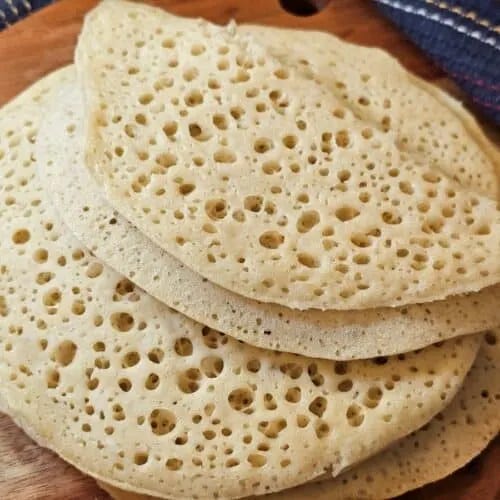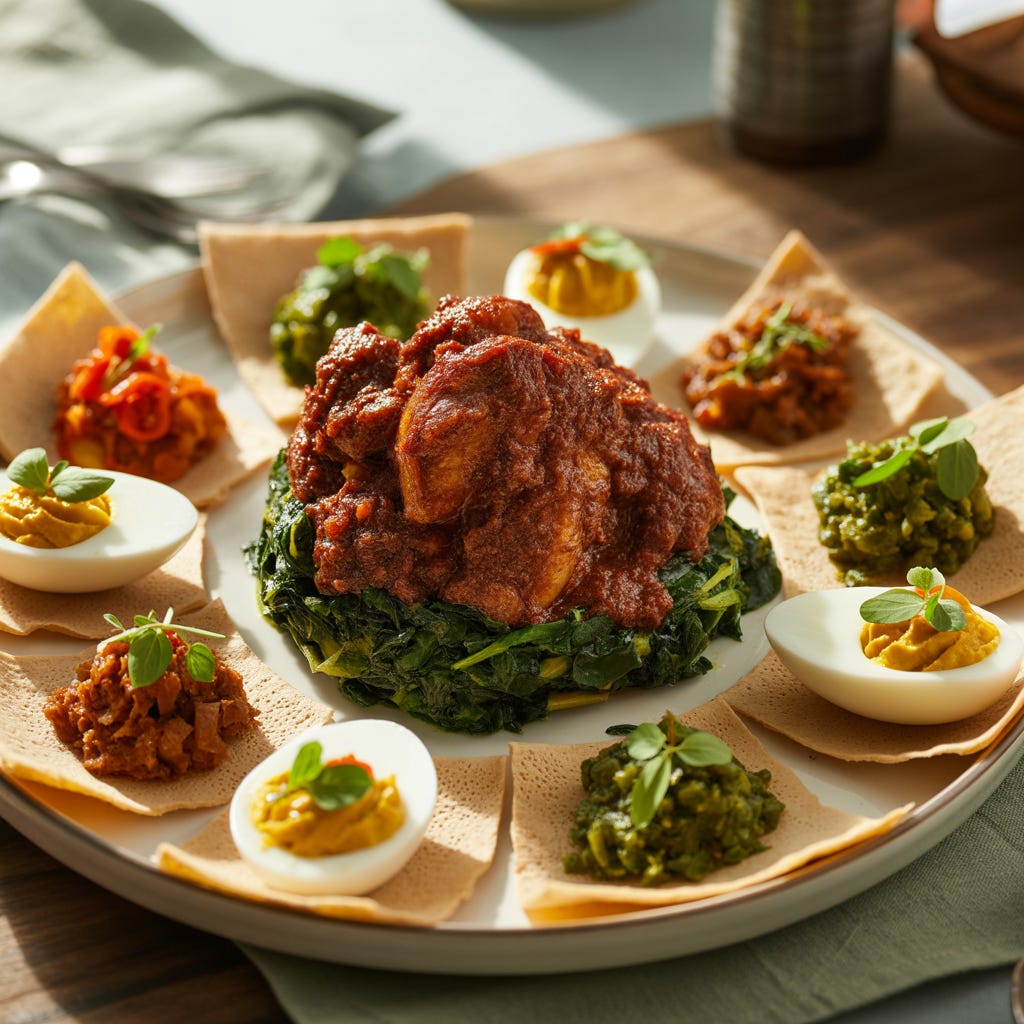The Jewish Curry Culture Club exists to celebrate precisely these moments: where geography meets memory, where migration stirs the pot, and where Jews across Asia and Africa have cooked with the tools of their neighbors while making the food distinctly their own.
From Ethiopia to Yemen, from Bombay to Baghdad, curry has been more than a dish. It has been a medium for adaptation, a symbol of welcome, a warm expression of place. And in each version, Jewish cooks have left their thumbprint — whether it be a Sabbath bread, a kosher tweak, or a story remembered in spice.
The first time I stepped into an Ethiopian restaurant, it was in Jerusalem. I remember the table: round, communal, and covered with one giant circle of injera — the spongy, slightly sour flatbread that doubled as both plate and utensil. On top were mounds of thick stews and vegetables — ochres, reds, browns — all served in gravity-defying dollops across the sour canvas. No knives. No forks. No serviettes.
Photo courtesy of Kimberly Killebrew (The Daring Gourmet)
You ripped a piece of injera, reached in, scooped with your right hand.
The flavours were intense — earthy, spicy, fermented, unfamiliar. And the absence of serviettes?
That was the hardest part for me. I didn’t grow up eating with my hands…
But something about that experience has stayed with me. Maybe it was the warmth of the food. Maybe it was its communal nature — the act of eating together from the same cloth. Maybe it was something deeper.
After all, the Jewish story doesn’t end in the familiar exile routes of Europe or the Middle East.
There are roads that wind beyond Babylon, far beyond even Bengal — across deserts, over mountains, across the Red Sea — and land in the highlands of Ethiopia.
Ethiopia and the Jewish World
The Beta Israel — the Ethiopian Jewish community — has long been a subject of both fascination and controversy.
Were they descendants of King Solomon and the Queen of Sheba? Of Dan, the lost tribe? Of Jewish traders who settled along ancient caravan routes? Or were they Ethiopian converts drawn to an imagined Zion?
Claudia Roden’s telling is clear-eyed and respectful.
In The Book of Jewish Food, she describes the Beta Israel as isolated for centuries, living in the highlands of Gondar and Tigray, following a version of Judaism with ancient echoes — animal sacrifice, laws of purity, Sabbath observance — but without knowledge of the Oral Law, the Talmud, or even the destruction of the Second Temple.
They lived simple lives as blacksmiths and weavers.
Their diet was mostly vegetarian — spiced lentils, chickpeas, cabbage, potatoes.
On Shabbat, meat stews like doro wat made appearances.
What’s striking is how their food, while unmistakably Ethiopian, became part of a Jewish rhythm.
Fast days were respected. Holidays were marked with special dishes.
Even without knowledge of the wider rabbinic world, they preserved a sense of Jewish distinction — through ritual, through story, and through food.
The Red Sea Nexus: Ethiopia, Yemen, and Beyond
Yemen lies just across the Red Sea — the very sea God parted to allow the freed Israelite slaves to escape the pursuing Egyptians.
And it shows. Ethiopia and Yemen — separated by a sea narrow enough for sailors to cross in a matter of days — developed mirror cuisines.
Spices like fenugreek, ginger, cumin, cardamom. Fermented breads. Fiery chili blends like berbere and zhug.
Lentil stews and slow-cooked meats served with flatbreads and no cutlery. For the Jews of Ethiopia and Yemen, spice wasn’t just heat — it was medicine, memory, and meaning.
Both communities have suffered discrimination for their skin colour and customs, both have been airlifted to Israel, and both have tried to hold onto their food as a thread linking them to a lost home.
What I didn’t realize then was how many stories had crossed the Red Sea to end up on my plate.
Our focus today is one of those mounds on the injera: a chicken curry called Doro Wat (Wat = curry in Amharic), considered to be the Ethiopian national dish.
But first, let’s put the Ethiopian kitchen in geographical and historical context.
Jewish Communities: Beta Israel and Yemenite Jews
The Yemenite Jewish community immigrated to Israel primarily in 1949–1950 during Operation Magic Carpet, which airlifted nearly 50,000 Jews to the newly founded state.
In contrast, the Ethiopian Jewish community, known as Beta Israel, are more recent arrivals, brought to Israel in two major waves: Operation Moses in 1984 and Operation Solomon in 1991.
I have always found similarities between the two kitchens.
What explains these similarities? Geography, trade, and migration.
Ethiopia and Yemen face each other across the Red Sea, just 30 kilometers apart at the Bab el-Mandeb strait. For millennia, merchants crisscrossed this passage, trading spices, gold, ivory, incense, and ideas. Jewish traders were among them.
The Red Sea trade route connected the Kingdom of Axum in Ethiopia with the Hadramaut region of Yemen and ports in India.
This exchange brought with it not just goods, but also flavours: pepper, ginger, turmeric, fenugreek, and techniques of spice blending. It is no accident that Ethiopian berbere and Yemenite hawaij resemble Indian masalas in method if not in taste.
Each culture developed its own spice grammar, but the rules — layering, blooming, slow cooking — are shared.
The Bread: Injera and Lachuch
Ethiopian food is almost always served with injera, a fermented flatbread made primarily of teff, a tiny ancient grain endemic to Ethiopia, considered a superfood. Its spongy texture and sour tang are the perfect foil for spicy stews.
You tear, scoop, and eat — no forks required. The injera acts as plate, utensil, and bread all in one.
Years later, I learned to make injera myself.
In my lawyer days, I met a young Israeli of Ethiopian heritage who invented a teff flour grinding machine. He became known worldwide for his invention. But injera isn’t alone in the world of Jewish breads. In fact, it has a long-lost cousin across the sea: Yemenite lahoh (or lachuch, as it is known in Israel). I have made those pillowy beauties too — especially when dunked in hilbe (fenugreek dip).
Like injera, lachuch is a fermented pancake-like bread with a porous surface and slight tang.
Made of wheat or sorghum flour, it is common in Yemen and Somalia.
Jewish Yemenites brought it with them to Israel, where it is served with soups like chicken hawaij or lamb hulba.
While the flours may differ, and lachuch is generally milder and smaller than injera, the shared logic of fermentation, texture, and function cannot be missed.
Berbere and Hawaij: Spice Logic
If berbere is Ethiopia’s signature curry powder, hawaij is Yemen’s. Though different in profile, they share a common culinary grammar: warm, earthy, aromatic, and built for slow-cooked depth.
Berbere: hot chilies, garlic, fenugreek, Ethiopian basil, ginger, coriander
Hawaij: turmeric, cumin, black pepper, cardamom (sometimes cloves, coriander, nutmeg)
Both are foundational — not finishing touches — transforming onions and oil into a base with soul.
Homemade Berbere Spice Blend
Ingredients
1 tsp fenugreek seeds
1 tsp coriander seeds
1 tsp cumin seeds
1 tsp black peppercorns
5 cardamom pods
4 cloves
1 small cinnamon stick
2 tbsp sweet paprika
2 tsp hot chili powder (adjust to taste)
1 tsp ground ginger
1 tsp ground turmeric
½ tsp ground nutmeg
¼ tsp ground allspice
¼ tsp salt
Method
In a dry pan, toast the whole spices over medium heat for 2–3 minutes until aromatic. Do not burn.
Grind to a fine powder and mix with the remaining ground spices.
Store in a sealed jar.
The Curry: Doro Wat — Berbere-Spiced Ethiopian Stew
A typical wat begins with niter kibbeh (spiced clarified butter) or oil, into which onions are slowly cooked until golden and soft.
Then comes the berbere, bloomed in the fat to release its fragrance, followed by tomatoes, garlic, and meat or legumes. The result is deeply warming, fiery yet aromatic.
Doro Wat is Ethiopia’s national dish: a richly spiced chicken stew, traditionally served with injera and hard-boiled eggs. The onions are caramelized, the spices intense, the result unforgettable.
The Recipe: Doro Wat
Adapted from Kimberly Killebrew (The Daring Gourmet)
Serves: 6
Time: 2.5 to 3 hours
Ingredients:
1.5 kg chicken thighs or bone-in pieces
Juice of 1 lemon
3 tbsp niter kibbeh (or ghee/butter + pinch of berbere, or margarine for kosher version)
2 tbsp vegetable oil
3 large onions, minced into a chunky purée
1 tbsp grated garlic
1 tbsp grated ginger
60 g (approx. ¼ cup) homemade berbere
1½ tsp salt
250 ml chicken stock
120 ml white wine + 1 tsp honey (or Ethiopian tej if available)
4 hard-boiled eggs, peeled and pierced
Method:
Marinate chicken in lemon juice for at least 30 minutes.
Heat oil and niter kibbeh in a heavy pot.
Add onions and cook over low heat, covered, for 45 minutes, stirring occasionally.
Add garlic, ginger, and a knob of butter. Cook another 20 minutes.
Stir in berbere and salt. Cook 30 minutes, stirring often.
Add chicken, stock, and wine. Simmer covered for 45 minutes until tender.
Add eggs and simmer 15 minutes more.
Serve with injera — or rice, if unavailable.
Like the recipe? here is a PDF recipe card to share
Doro wat Ethiopian chicken curry
Modern Doro Wat: A New Serving Suggestion
For those looking to present Doro Wat in a way that honors its roots while appealing to contemporary aesthetics, here’s a modern take inspired by Ottolenghi’s bold plating and Ethiopian-Jewish memory.
Picture this: At the center of a wide off-white ceramic plate lies a rich, deep-red mound of Doro Wat, its glossy berbere-infused sauce pooling over a bed of gently sautéed collard greens. Around it, torn or folded triangles of injera create both structure and softness — a canvas dotted with miniature mounds of traditional accompaniments: golden kik alicha (yellow split peas), spicy misir wat (lentils), and delicate tikil gomen (braised cabbage and carrot).
But here’s the twist: nestled between these stews are halved deviled eggs, not filled with yolk, but with the stews themselves — piped into each half with care, and garnished with micro herbs or tiny droplets of berbere oil. Each egg becomes a vessel of story — one holding spiced lentils, another cabbage, a third glowing with turmeric-dyed split peas. The dish is finished with a drizzle of vibrant green herb oil and a scattering of toasted nigella or sesame seeds.
It’s not just fusion. It’s a conversation. A plate that invites taste, memory, and reimagination — one spoonful at a time.
Why Include Ethiopia in a Jewish Curry Project?
Because doro wat is a curry — spiced, slow-cooked, rich with onions and heat.
Because Jews have eaten it — on Shabbat, on holidays, in exile, in return.
In traditional Beta Israel communities, Doro Wat was indeed the Shabbat dish — often called “Sabbat Wat.”
This wasn’t a different recipe, just a special name to mark the moment.
Like cholent, like hameen — it marked joy, presence, and Jewish continuity.
Curry and Continuity
Because Jewish food didn’t stop evolving in Baghdad or Bombay. It crossed the Red Sea and took root in the highlands. It fermented. It burned. It blossomed.
This is not fusion. It’s survival.
So next time you scoop up stew with your fingers and wonder where the serviettes are, remember — Jewish food has always been about adapting with dignity.
And sometimes, it gets a little spicy.
Shabbat Shalom.









Love this and im especially a fan of Ethiopian dishes here in Israel!